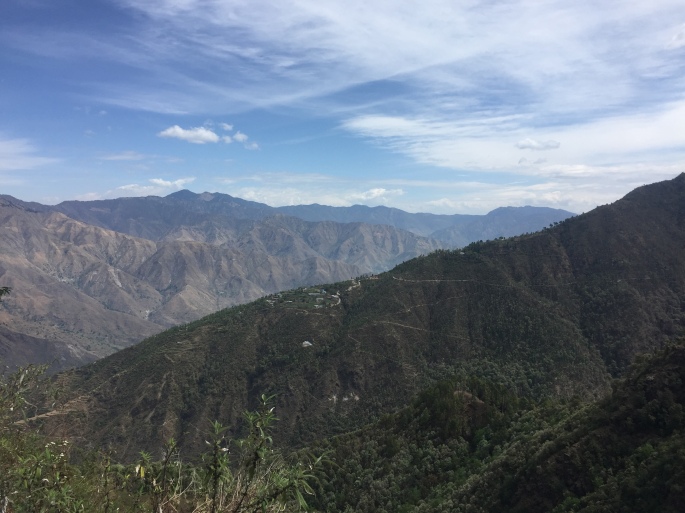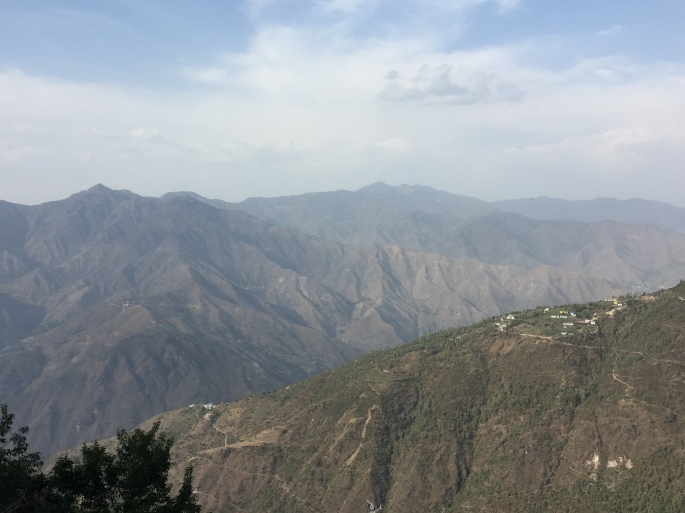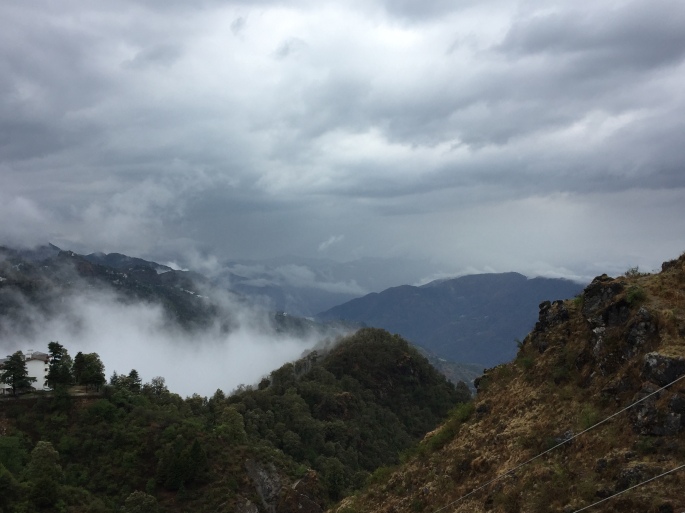7 April 2017
“I wanna know, have you ever seen the rain?
Comin’ down on a summer’s day”
Creedence Clearwater Revival
The last leg of my nine-hour journey into the foothills of the Garwhal Himalayas, is from Dehradun railway station to Mussoorie in Uttarakhand, and I complete it in a Hindustan Ambassador taxi. This legendary vehicle was in production from 1958 until 2014 and I am confident that the model I am occupying was produced at the early end of that date range. I don’t know much about cars, but I understand the Ambassador was modelled on the Morris Oxford, which is probably why the upholstery, dashboard and general interior environment, transport me instantly back to being driven home by friends’ fathers in the 1970s following after-school teas, although those childhood journeys did not involve such a precipitous route nor so much, if any, honking. It is a heart-stopping, near vertical ascent to my hotel (Mussoorie is 2000 metres above sea level) snaking along bendy mountain passes with sheer drops over the side. I am so relieved to arrive alive that I ask my driver if I can take a photo of him and his car: the result is shown below.

Mussoorie was founded by Lt Frederick Young of the East India Company in 1823 purely on the basis that he wanted to bag some game. I am afraid the town has lost a good deal of the romanticism it must have had then and is now a messy place, unsympathetically commercialised and with the air of a faded English seaside resort complete with amusement arcade, sorry paddle boats and garish municipal planting. But nothing can detract from the wonder of Mussoorie’s setting: the Doon valley tumbles away before it (see footnote) and at night the twinkling lights of Dehradun make it seem as if an enormous handful of precious stones has been tossed down the hillside. Meanwhile the Himalayas rise behind, and a distant view of snowy peaks is possible on clear days. But above all, and of course this is what attracted our forebears, the air in Mussoorie is magically fresh, there is a cool breeze and the temperature in the summer can be half what it is down in Delhi.
I am staying in a “heritage hotel” here, a term lavishly deployed in India to describe more or less any old (literally) building, and I have learned the hard way that it should not be taken as a kite mark for standards. All to often in practice, the term “heritage” is a fig leaf for shabbiness or lack of modern comforts especially where plumbing is concerned, and this dwelling house proves no exception. All the same, the proprietor is an engaging character who makes up for some of its shortcomings. We strike up an early rapport when I gently inquire whether he has spotted the irony of the hotel’s wifi password being “savetigers” when at the same time the floor of the lounge is adorned by a tiger skin complete with head. He looks suitably chagrined. “Madam” he says “ I hate that skin, but I am trying to preserve the building as it was 200 years ago, and it appears in old photos which are on the website, so sometimes guests ask to see it”. Even I cannot muster the energy to defend a 200 year dead tiger, so I back off, but am warmed to later observe four staff rolling up the offending pelt and stuffing it in a cupboard.
From then on the proprietor comes to have a chat with me at every meal time. This includes, on one occasion, requiring me to view on his (ancient) laptop, a constantly buffering YouTube video of an Oxford Union debate with the motion “This House believes Britain owes reparations for the Empire”, during which an Indian congress member Dr Shashi Tharoor, puts up a very spirited argument in favour, which my man then waits patiently for me to knock down even while I am trying to consume my (excellent) Gujarati thali. I am sure that I prove a disappointment, thrashing around as I do with a few unconvincing – including to me – points about the legacy benefits India received, and the fact that Britain did not have a monopoly on empire building at that time. But he’s undeterred: our discussions rage on good-naturedly for the next few evenings covering the pros and cons of Partition, the corruption – in his view – which has hampered successive Indian governments since Nehru, the leadership qualities of Indira Gandhi, and all points between.
After all that, it’s something of a relief for me to clamber down from the Cross of British imperialism and get out in the fresh air. I decide to eschew the delights of Mussoorie in favour of its upstairs neighbour Landour (nostalgically named by the British after Llanddowror in Wales), which is a further thousand feet towards the sky and largely untroubled by visitors on the grounds that there is said to be “nothing there”. Apart from the Himalayas that is. My request for a ride to the village clock house creates consternation at the taxi stand, as it is not listed on the menu of fixed price or round trip destinations on offer to tourists, but eventually a willing victim is identified to propel me there for 200 rupees (he fails to pick me up again at the appointed time but that’s another story).
On arrival, I start the ascent to Lal Tibba which is the highest point in these parts, and involves a fairly steep climb through lush deciduous forests of deodar (a cedar like tree native to the Himalayas) and oak, beneath which rhododendrons flower thickly. Myriad birds occupy trees through which monkeys swing, and, occasionally – though not today sadly – a leopard can be spotted. It’s a really lovely walk, made all the better both by the fact that there is nobody else anywhere to be seen and by the weather: it’s sunny as I progress uphill but there is a damp atmosphere following huge thunderstorms overnight. When I emerge at the summit, I realise I am in the sun but looking down on clouds, which form a frothy veil scudding across the valley. It is a unique and uplifting sight which I absorb silently for a while. Then the sky suddenly darkens and it starts raining very heavily so I descend quickly back into the village, pausing only to peep into St Paul’s on the way down, an Anglican church which is straight out of the English shires, and the four little shops known as Char Dukan which nestle at its foot. They offer a range of refreshments to anyone who makes it this far. I haven’t used this blog (yet) to describe what I’ve been eating in India but one positive aspect of my recent diet is that refined sugar has barely had a look in, not because of any deliberate restraint on my part but because it just isn’t so easily available as back home. Until today. The cafe I enter is displaying some very appetising cakes and after my hike, I decide I can justify a piece of red velvet. So I sit down with this and a cup of tea, look out into the surrounding forest and remind myself, with a degree of disbelief, that I’ve achieved a lifetime’s ambition to set eyes on the Himalayas, and even trek in their foothills (it may not be Everest – which is only properly visible from Nepal anyway – but it’s good enough for me!). Perhaps it’s my brain reacting to the unaccustomed sugar rush, or an overdose of much-needed oxygen, but, for the next few minutes at least, I’m determined to savour the feeling that for once, all is right with the world.
Footnote: I realise that nothing ever lacks perspective like a photograph of mountains: they really have to be viewed with the naked eye, but even so, here are a few images which might convey a small sense of the beauty of this place. Try to imagine them in 3D! And as much as I love the previous cover photo on the blog (which was of the meadows on the Valley floor in Yosemite National Park), I’ve replaced it with the view looking down the Doon valley from Mussoorie.



